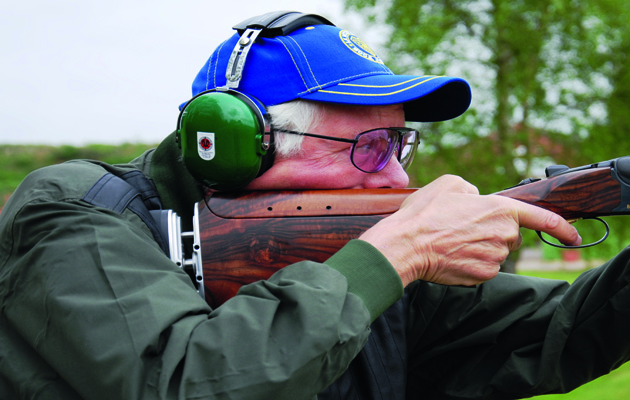How to reduce recoil
DTL and Olympic skeet champion Jim Sheffield has had great results with the Gracoil recoil reducing system

Before Christmas, I treated myself to a second-hand Beretta DT10X trap gun that was in excellent condition. I managed to negotiate a significant reduction in the asking price because the previous owner had shortened the stock by about 7/8in and then had the original piece of wood that had been removed expertly re-fitted. To my mind, the butchery that had gone on, notwithstanding the exceptional workmanship of the alteration, detracted from the gun’s overall appearance and also its long-term value as an investment.
I had a strong suspicion that the previous owner had some kind of recoil reducing system fitted and the stock had been shortened to accommodate this. My hypothesis proved correct when the reattached piece of wood was removed, revealing inletting inside the stock to accept some sort of butt-plate-based recoil reducer.
Restoring the gun
My restoration options from that point onwards were as follows:
• Buy a brand new factory-finished adjustable stock from GMK, the Beretta importer, at a cost of over £1,200 and risk that the colour and figure in the wood might not match the fore-end.
• Make an appointment with Italian stock makers Essevierre in Gardone, and then fly to Italy with my gun to get a new stock made to my specific requirements at a cost of just under £1,000.
• Research recoil reducing systems, select the best one I could find from an aesthetic, engineering and practical trap shooting perspective and have it fitted for a fraction of the costs of the other alternatives.
I was not entirely unknowledgeable about recoil reducers. Forty years ago, while living in Canada, I experimented with the US-made Edwards recoil reducing system fitted inside the stock of a Winchester model 12 trap gun. Fifteen years ago, when back in the UK, I experimented with a mercury filled recoil reducer made by C&H Research, fitted inside the stock of a Beretta 682 trap gun, which I used for Olympic trap. Both systems seemed to reduce recoil, but I came to the conclusion they did so mainly by increasing the overall weight of the gun rather than by any other means.
For my restoration requirement, my focus was entirely on spring or hydraulic recoil reduction systems that could be fitted between my gun’s shorter stock and a recoil pad that would engage with my shoulder.
After some research, I discovered Graco products, which are stocked by Simon Willmore at Doveridge Gun Repairs, based in Derbyshire. The Gracoil recoil reduction system uses a spring compression butt-plate available in two versions. One has a length of pull adjustment and the other does not. Both models have a full range of pad adjustment as well as adjustable spring tension settings. This allows each individual shooter to set the system up to their particular needs.
I contacted Simon and discussed my requirements. A week later I drove to see him with my Beretta DT10X and we discussed the options for moving forward after he had examined my gun’s stock.
Quality manufacturing
I was keen to see the Gracoil products. My initial reaction was that they were extremely well designed, being made from aluminium and stainless steel. A lot of thought had gone into them. As an engineer, the quality of the manufacturing and finish also impressed me – I was reminded of the innards of a very large Swiss watch – in fact, the workmanship was really far too neat to hide from the light of day. I could not think of any reason for not progressing, so it was just a matter of choosing which of the two Gracoil variants to select. That proved an easy decision too. I chose the GC15 LP model which incorporates a length of pull adjustment.
Simon set to work fitting the GC15 LP system to my stock while I went off to have a late breakfast and to read the newspapers.
Two hours later the fitting had been completed. Simon had done a superb job. He showed me how all the possible adjustments could be made and set up the length of pull (143/4iin) that I requested. The spring tension in the recoil system can be adjusted from 14lb to 70lb. Simon set this to the maximum because I did not want the gun trying to emulate a trombone when I fired it. I have never suffered from recoil when shooting the DT10X, which weighs around 9lb, but who knows, perhaps the next owner will be different.
In the field
Shooting the gun at DTL at Kibworth gun club was an interesting experience. Using a mixture of Express Super Comps and Supremes, the recoil sensation was minimal. All I could feel was a slight “push” rather like shooting a .410 or a 28-bore.
Some people told me before embarking on this project that I would destroy the balance of my gun through adding a recoil reducing system to the stock. Had the gun not been a trap gun, which is pre-mounted before calling for the target, then I might have agreed. However, adding weight, as my project has required, has not affected the shooting characteristics of my gun at all.
In conclusion, I can heartily recommend the Gracoil system to anyone looking for an effective solution to the issues that faced me. The cost? Around £250, plus the reasonable price of an excellent breakfast during a short wait in Doveridge.








